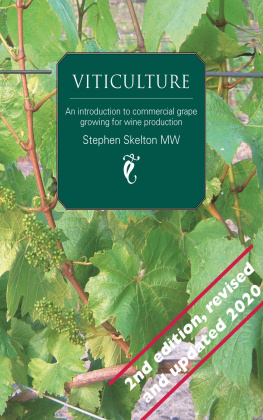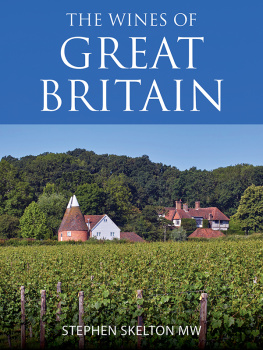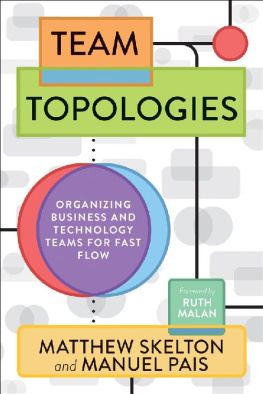Stephen Skelton - Viticulture
Here you can read online Stephen Skelton - Viticulture full text of the book (entire story) in english for free. Download pdf and epub, get meaning, cover and reviews about this ebook. year: 2020, publisher: S P Skelton Ltd, genre: Romance novel. Description of the work, (preface) as well as reviews are available. Best literature library LitArk.com created for fans of good reading and offers a wide selection of genres:
Romance novel
Science fiction
Adventure
Detective
Science
History
Home and family
Prose
Art
Politics
Computer
Non-fiction
Religion
Business
Children
Humor
Choose a favorite category and find really read worthwhile books. Enjoy immersion in the world of imagination, feel the emotions of the characters or learn something new for yourself, make an fascinating discovery.
- Book:Viticulture
- Author:
- Publisher:S P Skelton Ltd
- Genre:
- Year:2020
- Rating:5 / 5
- Favourites:Add to favourites
- Your mark:
- 100
- 1
- 2
- 3
- 4
- 5
Viticulture: summary, description and annotation
We offer to read an annotation, description, summary or preface (depends on what the author of the book "Viticulture" wrote himself). If you haven't found the necessary information about the book — write in the comments, we will try to find it.
Viticulture — read online for free the complete book (whole text) full work
Below is the text of the book, divided by pages. System saving the place of the last page read, allows you to conveniently read the book "Viticulture" online for free, without having to search again every time where you left off. Put a bookmark, and you can go to the page where you finished reading at any time.
Font size:
Interval:
Bookmark:

VITICULTURE
An introduction to commercial
grape growing for wine production
Revised and updated second edition 2020
Stephen Skelton MW
S P SKELTON LTD
Published by S P Skelton Ltd
1B Lettice Street
London SW6 4EH
Phone (+44) 07768 583700
Copyright 2007, 2020
Stephen Skelton
All rights reserved
First published in paperback
in Great Britain in 2007. Second
edition first published in Great
Britain in 2020.
Stephen Skelton has asserted his
right under the Copyright, Designs
and Patents Act 1988 to be identified
as the author of this work
ISBN 978-0-9931235-9-7
Also available in paperback
ISBN 978-0-99312-357-3
All rights reserved. Apart
from any use permitted under UK
copyright law, this publication
may only be reproduced, stored
or transmitted, in any form, or
by any means, with prior permission
in writing of the publishers or,
in the case of reprographic
production, in accordance with the
terms of licences issued by the
Copyright Licensing Agency.
Every effort has been made to
fulfil requirements with regard to
reproducing copyright material.
The author and publisher will be glad
to rectify any omissions at the
earliest opportunity.
Cover illustration:
A young Chardonnay vine, just
before flowering, at Peter Halls
Breaky Bottom Vineyard, Lewes,
East Sussex, Great Britain
Printed volume design
Geoff Green Book Design, Cambridge
eBook coding and production
eBook Versions
27 Old Gloucester Street
London WC1N 3AX
www.ebookversions.com
Contents
Vine physiology
Parts of the grapevine
Leaves, shoots, clusters
Leaves
Shoots
Clusters and tendrils
Woody parts cordons, canes and trunks
Below the soil the root structure
Mycorrhizal fungi
Internal processes of the vine
The circulatory system of the vine Vascular system
Drinking and sweating the movement of water through the vine
The Food Source Photosynthesis
Eating Respiration
Clones of grapevines
Mass selection of clones s lection massale
Natural mutations Chimeras
Producing new varieties by cross-breeding
Hybrid grape varieties
DNA profiling
Genetically modified (GM) grapevines
Production of grapevines
Rooted cuttings
Grafted grapevines
Top-grafting
Layering provignage
Repiquage
Climate Macro-, Meso- and Microclimate
Climatic influences
Measurement of climate at macroclimate level
The length of the growing season
Summary on climate measurement
Climate change and global warming
Site selection at the mesoclimate level
Location, Altitude, Aspect
Proximity to bodies of water
Diurnal temperature variation
Conclusion to site selection
Table 1: Grapegrowing regions of the world (2019)
Climatic differences
Climate and location
White grape varieties
Table 2: Most widespread white wine grape varieties
Red grape varieties
Table 3: Most widespread red wine grape varieties
Topsoil
Subsoil
Subsolum
Soil pH
Humus in soils
Availability of water
Terroir A concept not easily grasped
Precision viticulture
Site preparation
Ploughpan
Drainage
Green manures
Windbreaks
Hail netting
Protection against predators
Frost protection
Winter frost
Spring frost
Vineyard layout
Planting vines
Care of vines after planting
Weed control in vines
Pruning an overview
Canopy management
High vigour vineyards
High-density or low-density vineyards?
Row width
Intervine distance and vine densities
Trellis height
Height of fruiting wood
Downward trained vines
Types of pruning
Cane pruning
Cane pruning conclusions
Spur pruning
Spur pruning conclusions
Minimal pruning
Different trellising, training and pruning systems
Trellising, training and pruning systems summary
Materials used in trellising, training and pruning systems
January-February-March
April-May
June-July
July-August
September-October
November-December
Yields and quality is there a relationship?
The relationship between vine age and quality
Water sources
Quality of water
Types of irrigation
Monitoring the water requirements in the vineyard
How much water to apply?
Partial Rootzone Drying (PRD)
Irrigation a summary
Rudolf Steiner
Organic and Biodynamic practices
Organic and Biodynamic does not mean not sprayed
Costs of production in organic and Biodynamic vineyards
Are organic and Biodynamic wines better than conventional ones?
Organic and Biodynamic viticulture a summary
Integrated Pest Management (IPM)
Harvest intervals
Roses and vines
Diseases caused by fungi, bacteria and bacteria-like organisms
Botrytis Pourriture Gris , Grey Mould, Grey Rot
Botrytis Noble Rot Pourriture Noble , Edelfule
Downy Mildew Peronospera, Mildiou
Oidium Powdery Mildew
Further diseases in alphabetical order
Viruses of grapevines
Trunk diseases
Phylloxera in Europe
Rootstock development
Types of rootstock
Phylloxera and the Californian experience
Vineyards on their own roots
Modern developments in Phylloxera control
Pre- Phylloxera vines and wines
Conclusion Phylloxera
Mineral requirements of vines
Major elements
Minor and trace elements
Other viticultural problems
Units of measurement
Area: | 1 hectare (ha) = 100 ares |
1 are = 100 square metres | |
Therefore | 1 ha = 10,000 square metres |
1 acre = | 43,560 sq. feet, 4,840 sq. yards, or approx. 4,047 sq. metres |
Approx. 2.471 acres = 1 ha | |
Weight: | 1 tonne = 1,000 kilograms (kg) |
1 ton (Imperial) = 2,240 lbs or approx. 1,016 kg | |
1 ton (US) = 2,000 lbs or approx. 907 kg | |
Volume: | 1,000 litres = volume of 1,000 kg (1 tonne) of water at sea-level at 20C |
1 hectolitre (hl) = 100 litre | |
Yields: | 1 tonne per hectare = approx. 7 hl/ha (see note below) |
1 tonne per acre = approx. 17 hl/ha |
Note:
The volume of juice/wine produced from 1 tonne of grapes will depend on several factors: the type of press, degree of pressure, grape variety, whether pressed pre-fermentation (white grapes) or post-fermentation (red grapes), whole-bunch pressed, crushed and not de-stemmed or crushed and de-stemmed, machine harvested etc. The output of liquid from 1 tonne of grapes for still wines will vary between 775 litres (extreme) and 650 litres (low).
For sparkling wines using the official mthode Champenoise, 4,000 kg of grapes may yield 2,050 litres of cuve juice and another 500 litres of taille a total of 2,550 litres or 637.5 litres per tonne. Any additional juice pressed (known as the rebche) is used for table wine or distillation. The best champagnes and sparkling winemakers only use the cuve.
Acknowledgements
This book is a compilation of my personal knowledge, experience and research gained by working with vines since 1975, plus a huge amount of delving into the published works and internet postings of others. Chief amongst these published works, in alphabetical order, are:
Next pageFont size:
Interval:
Bookmark:
Similar books «Viticulture»
Look at similar books to Viticulture. We have selected literature similar in name and meaning in the hope of providing readers with more options to find new, interesting, not yet read works.
Discussion, reviews of the book Viticulture and just readers' own opinions. Leave your comments, write what you think about the work, its meaning or the main characters. Specify what exactly you liked and what you didn't like, and why you think so.









